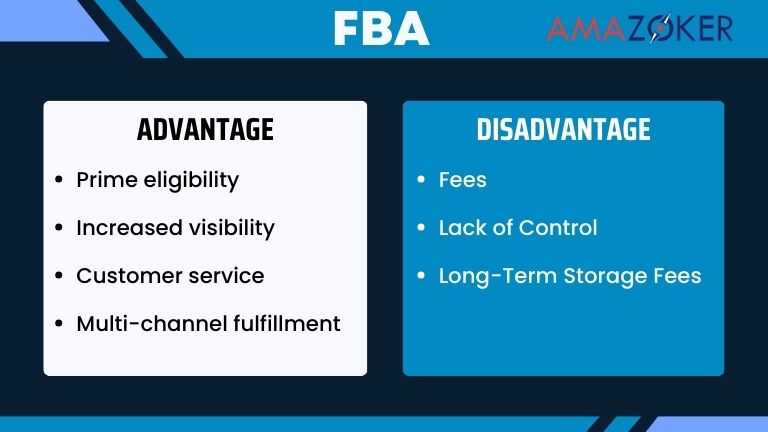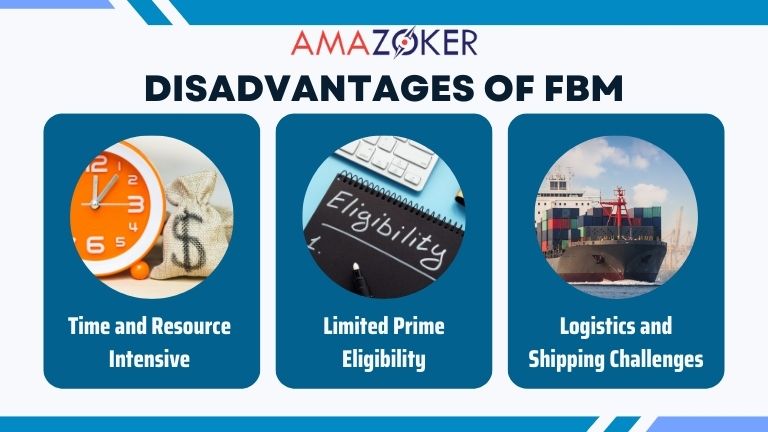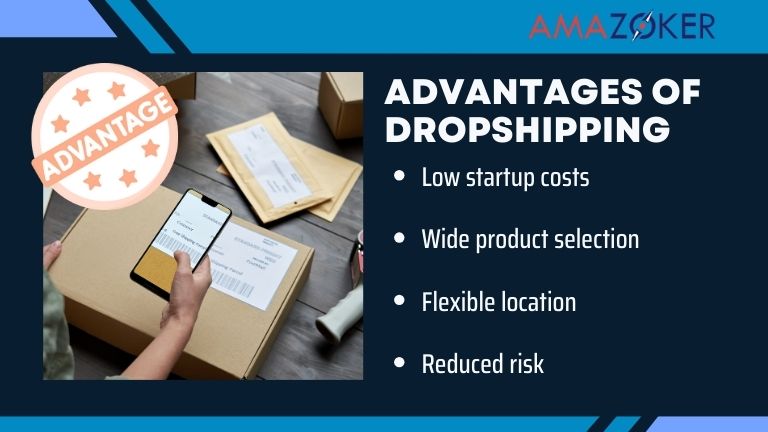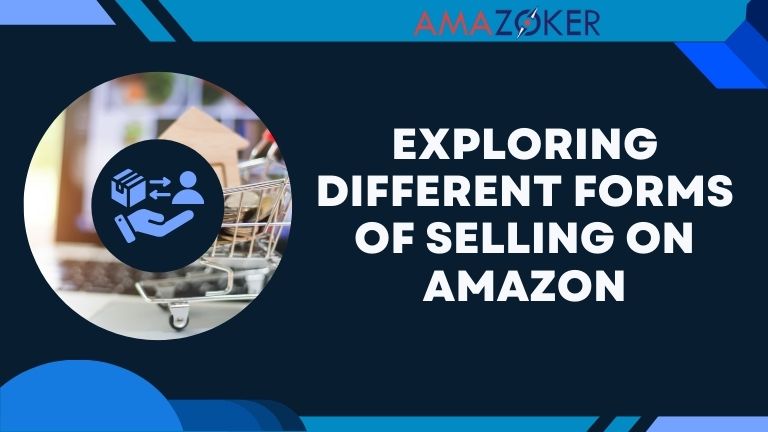When it comes to selling products on Amazon, there are several different methods that sellers can utilize to reach their customers. Each method has its own set of advantages and disadvantages, so it’s important for sellers to carefully consider which approach is best for their business. In this article, we will explore three popular forms of selling on Amazon: FBA, FBM, and Dropshipping.
Table of Contents
Fulfillment by Amazon (FBA)
Fulfillment by Amazon (FBA) is one of the most popular forms of selling on Amazon for sellers who want to take advantage of Amazon’s vast fulfillment network. With FBA, sellers send their products to Amazon’s fulfillment centers, and Amazon takes care of storing the products, picking, packing, and shipping orders, as well as providing customer service and handling returns.

The advantages and disadvantages of Fulfillment by Amazon
Advantages of FBA
There are several advantages to using Fulfillment by Amazon as for your business:
- Prime eligibility: By using FBA, your products become eligible for Amazon Prime, which can attract more customers and increase sales.
- Increased visibility: Amazon’s vast customer base and global reach can help increase the visibility of your products, making it easier for customers to find and purchase them.
- Customer service: FBA provides customer service support for your products, including handling returns and inquiries. This can help enhance the overall customer experience and reduce the burden on your business.
- Multi-channel fulfillment: FBA allows you to fulfill orders from other sales channels, such as your own website or other online marketplaces, using Amazon’s fulfillment network. This can streamline your operations and provide a consistent fulfillment experience across different platforms.
Disadvantages of FBA
While FBA offers several advantages for sellers, it’s important to also consider the potential drawbacks. There are also some disadvantages to using FBA, including:
- Fees: The convenience of FBA comes with associated fees. Sellers are required to pay various fees, including storage fees, fulfillment fees, and additional charges for certain products. These fees can eat into profit margins, especially for low-priced or slow-moving products.
- Lack of Control: By relying on FBA, sellers give up some control over the fulfillment process. This means relying on Amazon to pack and ship orders correctly, handle customer service, and manage returns. Any errors or delays in these areas can impact customer satisfaction and seller reputation.
- Long-Term Storage Fees: FBA charges long-term storage fees for products that have been in storage for more than 365 days. If your inventory doesn’t sell well or if you have excess stock, these fees can add up and negatively impact profitability.
Fulfillment by Merchant (FBM)
Another form of selling on Amazon is FBM, also known as Fulfilled by Merchant. Fulfillment by Merchant is the alternative to FBA. FBM requires sellers to handle the storage, packaging, and shipping of their products directly to customers. This method gives sellers more control over the fulfillment process but also requires more hands-on involvement.

FBM entails a considerable Number of Drawbacks
Advantages of FBM
FBM can be a good option for businesses that are just starting out or are experiencing rapid growth because of several advantages, including:
- Cost Control: With FBM, sellers have more control over their costs compared to using third-party fulfillment services. They can avoid fees associated with storage, fulfillment, and other services offered by fulfillment centers, which can be particularly beneficial for sellers with tight profit margins or unique products.
- Flexibility and Customization: FBM allows sellers to have complete control over the entire fulfillment process. They can choose their preferred shipping carriers, packaging materials, and shipping methods. This flexibility enables sellers to tailor the fulfillment experience to their specific brand and customer needs, providing a more personalized touch.
- Branding and Customer Experience: With FBM, sellers have the opportunity to create a unique and branded customer experience. They can customize packaging, include personalized notes or promotional materials, and ensure that every aspect of the fulfillment process reflects their brand. This can help strengthen brand loyalty and differentiate themselves from competitors.
- More Control Over Returns: With FBM, sellers have complete control over the returns process. They can establish their own return policies, handle returns directly, and have more flexibility in resolving customer issues. This level of control can lead to faster and more efficient returns processing, enhancing customer satisfaction.
Disadvantages of FBM
While FBM offers certain advantages, it also comes with its fair share of disadvantages.
- Time and Resource Intensive: FBM requires sellers to dedicate time and resources to handle all aspects of fulfillment. This includes storing inventory, packing orders, arranging shipping, and managing customer service inquiries. For sellers with limited resources or those looking to focus on other aspects of their business, this can be a significant challenge.
- Limited Prime Eligibility: One of the downsides of FBM is that sellers are not automatically eligible for Amazon Prime. Prime members enjoy benefits such as free two-day shipping, and not having Prime eligibility can potentially put FBM sellers at a disadvantage compared to FBA sellers.
- Logistics and Shipping Challenges: Without the support of a third-party fulfillment service, sellers are responsible for managing the logistics of shipping. This can involve coordinating with multiple shipping carriers, dealing with shipping delays, and potentially facing higher shipping costs. These challenges can impact delivery times and customer satisfaction.
Dropshipping
Dropshipping is a unique form of selling on Amazon where sellers do not keep the products they sell in stock. Instead, when a seller makes a sale, they purchase the item from a third party and have it shipped directly to the customer. This method requires minimal upfront investment but also comes with its own set of challenges.

While dropshipping may not work for all businesses, it offers numerous benefits
Advantages of Dropshipping
While dropshipping may not be the right fit for every business, there are several advantages to this model that make it an attractive option for many.
- Low startup costs: Dropshipping eliminates the need for upfront inventory investments, as you only purchase products once you have received orders from customers. This renders it a cost-effective choice for entrepreneurs with restricted funds.
- Wide product selection: With dropshipping, you can offer a wide variety of products to your customers without having to stock them yourself. You can partner with multiple suppliers and expand your product range to meet customer demands.
- Flexible location: Dropshipping allows you to operate your business from anywhere with an internet connection. You have the flexibility to operate your business remotely, work from the comfort of your own home, or even manage it while traveling.
- Reduced risk: Since you only purchase products once you have received orders, there is less risk of being stuck with unsold inventory. This can help minimize financial risks associated with traditional retail models.
Disadvantages of Dropshipping
Dropshipping offers several advantages, including low startup costs, flexibility, and scalability. Nevertheless, it also presents a unique array of obstacles, comprising of:
- Lower profit margins: Since you are not purchasing products in bulk, the profit margins for dropshipping are generally lower than other forms of selling on Amazon. This is because you will be paying the wholesale price for each product, which can significantly impact your profits.
- Limited control over the shipping process: Since you rely on the supplier to fulfill and ship orders, you have less control over the shipping process. This can lead to potential delays, errors, or issues with customer service that are beyond your control.
- Increased competition: Dropshipping has become popular in recent years, leading to increased competition in the market. It can be challenging to stand out and differentiate your business from others selling the same or similar products.
In conclusion, each form of selling on Amazon has its own set of pros and cons. Sellers should carefully consider their business needs, resources, and long-term goals when choosing the right selling method for them. Whether it’s leveraging Amazon’s fulfillment network with FBA, taking control of the fulfillment process with FBM, or exploring the flexibility of dropshipping, there are options available to suit a wide range of seller needs on Amazon.











